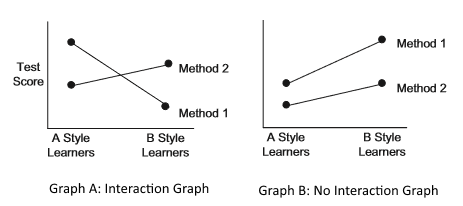7.1 Learning
Topic: Do People Differ in How They Learn?
Statistical Concepts Covered: In this applet, you’ll learn that in some research designs we are interested in looking at and interpreting the main effects and interaction. The main effect is the impact of a single variable on what we are measuring, while the interaction is the combined impact of two main effects on what we are measuring. It is also important to investigate studies that replicate findings to determine the confidence we should have in the results.
Introduction
The Learning chapter covered ways for you to promote your own learning in the classroom. It has long been thought that there are different styles of learners, primarily visual and verbal, and that instructional methods should be tailored to each learner’s strength. The attribute-treatment interaction (ATI) hypothesis states that visual learners do better when provided with visual instruction methods and verbal learners do better when provided with verbal instruction methods. This applet will allow you to explore data that was collected as part of a study investigating this hypothesis (Massa & Mayer, 2006).
A subset of data from the study compares the average scores on a learning test where help was offered either through pictures (pictorial condition) or through words (textual condition). Visual learners (visualizers) were determined based on high scores on spatial ability, visual cognitive style, or visual learning preference, while verbal learners (verbalizers) were determined based on high scores on verbal ability, verbal cognitive style, or verbal learning preference. The study set forth to determine whether there was a difference in learning between visualizers and verbalizers when they were assigned either pictorial or textual help. It was expected that visualizers would learn more in the pictorial condition, while verbalizers would learn more in the textual condition.
.
